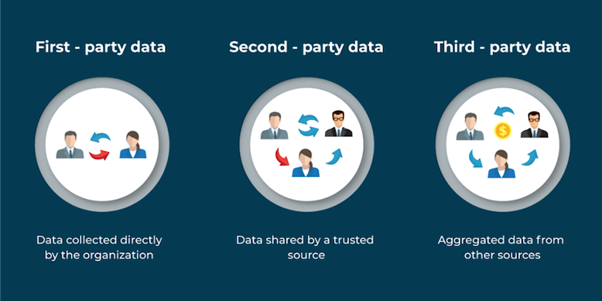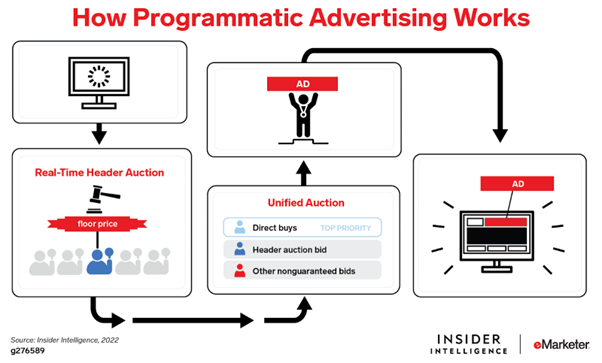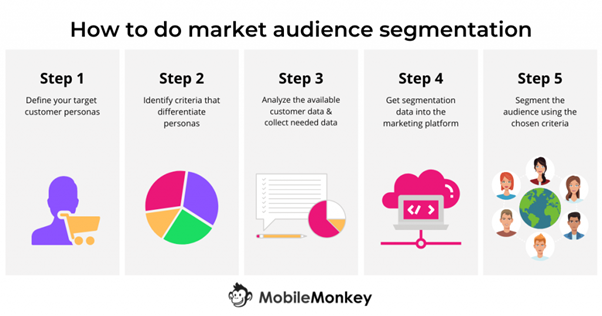With advancements in technology, programmatic advertising has become more precise and efficient. Companies that use programmatic advertising benefit greatly from first-party data, which allows them to reach relevant audiences with the right message and timing. Therefore, first-party data in programmatic advertising is crucial for accurate targeting and higher ROI than other forms of digital marketing. It is also critical for businesses to remain compliant with data protection regulations such as GDPR and CCPA.
In 2020, programmatic advertising accounted for 78.4% of US ad spending, according to McKinsey. Programmatic advertising spending is anticipated to reach $120 billion in 2023, growing even more quickly than previously anticipated.
First-party data is information provided directly to your organization by your client through sources owned by your company. The clients could either be your website visitors or someone who buys products or services from your site. The sources could be online, such as websites, apps, and interactions with digital paid ads, or offline, such as point-of-sale and after-sale contact.
In this blog post, we will discuss the role of first-party data in programmatic advertising and how it can help you maximize your marketing efforts and ROI.
Role of first-party data in Programmatic Advertising
Today's businesses understand the importance of data-driven decision-making. When it comes to programmatic advertising, first-party data is key and here's why:
- First-party data is less expensive, more accurate, and enables a more personalized client experience, hence it plays an important role in programmatic advertising to better target ads and increases conversion rates.
- Businesses must collect and operationalize first-party data to comply with evolving privacy regulations
- Marketers can create campaigns that underscore personalization. Your campaigns focus on your ideal client by leveraging first-party data, increasing the likelihood that they will take the desired action.
Programmatic advertising can also use third-party data, but it is less effective than first-party data.
Types of Data (1st, 2nd, and 3rd Party data)
Three primary types of data are used in programmatic advertising: first-party data, second party data, and third-party data.

First-party Data
First-party data is collected directly from the advertiser’s website or app. This could include information such as page views, time spent on site, items added to a shopping cart, and other interactions with the advertiser’s online property. First-party data is considered the most valuable type of data because it allows advertisers to create targeted campaigns based on the specific behavior of their clients.
Second-party Data
Second party data is data that is shared between two companies with a mutual understanding that it will be used for marketing purposes. This type of data is often collected by publishers, who then sell it to advertising networks or other types of marketers. Because second party data has already been segmented by audiences and organized by the publisher, it can be very valuable for marketers who are looking to target specific audiences.
Third-party Data
Third-party data examples include data from governmental, nonprofit, and academic sources or from e-commerce or any online service platform which are often shared or bought and sold on data marketplaces or exchanges. While third-party data can be useful for targeting because it is cookie-based, it is often less accurate than first or second-party data, and other tracking methods can produce inaccurate results.
Third-party Cookieless World
According to reports, third-party cookies are on the decline. Marketers are shifting towards a third-party cookie-less world where advertising is directed to people based on data about them that a company has collected itself. First-party data is preferred over third-party cookie data because it is based on what people have actually done, rather than on what someone thinks they might do.
Another advantage of first-party data is that it gives you more control over how your ads are targeted. Walled gardens are closed systems in which publishers own and control their entire advertising platform. When you use third-party cookies, you’re relying on cookies placed on people’s browsers by other companies where you don’t have any control over who sees your ads or how they’re being targeted.
If you want to ensure that your ads are only being shown to people who are likely to be interested in them, then using first-party data is the way to go.
Benefits of using first-party data in Programmatic Advertising
First-party data can be used to improve targeting, drive higher ROI, and increase transparency in the programmatic ecosystem.

1. First-Party Data Is more accurate
There are several reasons why first-party data is more accurate:
- First-party data is collected directly from the source – the consumer.
- First-party data can be verified by the company that collects it.
- First-party data is usually collected through opt-in methods, such as surveys or sign-ups for newsletters.
Overall, the capabilities of campaign performance increase with first-party data. It is far more accurate than third-party data because it comes directly from the source and can be verified by the company that collects it. This means that consumers are deliberately providing their information which is more accurate and up-to-date, and are therefore more likely, to be honest about it.
2. Better targeting
First-party data allows marketers to target their audience with laser precision. They can segment audiences by demographics, interests, behaviors, and custom criteria. This ensures that ads are delivered to those most likely to convert.
Here are a few examples of how First-party data creates better targeting:
- First-party data can be used to bid on keywords and placements that are more relevant to the company’s products or services.
- First-party data can be used to create custom audiences for better targeting that are more likely to convert into clients.
- Using first-party data in programmatic advertising provides better targeting and results in more effective campaigns.

3. A better understanding of the client journey stages
To optimize the client's journey, it's important to have a complete understanding of how clients interact with your brand. This includes understanding the stages of the client journey and what motivates clients at each stage. The typical client journey can be broken down into three stages: Awareness, Consideration, and Decision.
Awareness is when the client becomes aware of their problem or need. They begin to search for information on potential solutions.
Consideration is when the client narrows down their options and compares different solutions. During this stage, they may seek out reviews, pricing information, or product specs.
The decision is when the client buys or chooses a particular solution. They may be influenced by discounts, free shipping, or positive reviews from other clients.
By understanding these stages, businesses can create targeted marketing campaigns that speak to clients at each stage of their journey.
4. Insights into client lifetime value
First-party data lets marketers understand how clients interact with their brand and cross-channel interactions. This understanding is essential for developing effective marketing strategies and programs that drive client lifetime value.First-party data can be used to segment audiences and create detailed profiles of individual clients.
Some of the key insights that can be gleaned from first-party data include:
- What is the client procurement process?
- What is the average order value?
- What is the typical lifespan of a client?
- How much does a client typically spend over their lifetime?
- What are the key touchpoints in the client journey?
- What are the main reasons for client churn?
Insights into a client's lifetime value help marketers develop deeper relationships with their clients. They can develop marketing strategies and programs tailored to each stage of the client's lifecycle. Ultimately, this leads to higher conversion rates, lower churn rates, and improved client lifetime value.
5. Your competitors don’t have the same data
First-party data can be used to create detailed buyer personas and then use those personas to inform your programmatic ad targeting. Your competitors may have some of this same information, but they probably don’t have as much detail as you do. They may also be unable to target their ads as effectively, since they don’t have the same level of understanding as their clients. As a result, your programmatic ad campaigns will likely be more successful than theirs.
6. Helps refine a more personalized brand experience
First-party data is essential for creating a personalized brand experience. It allows you to target your audience more accurately and deliver relevant ads that resonate with them. First-party data increases transparency in the programmatic ecosystem. Marketers can see exactly who they’re targeting and what they’re paying for each ad impression. This level of transparency is not possible with other forms of advertising, such as traditional media or display advertising.
Sources to gather first-party data for advertisers
Prospecting, building relationships, and persuading to take some action is often the advertiser's goal. Advertisers can use website data, CRM data, social media data, and mobile data as primary sources to track user behavior wherever they click on their own website to better understand how people interact with their brand online.
CRM systems (online and offline)
CRM data includes email addresses, client names, contact information, buying history, and other similar data points. By integrating CRM data with programmatic ad platforms, you can target ads more precisely and efficiently to individuals who are more likely to be interested in your products or services.
There are two main types of CRM systems: online and offline
Online CRM systems are typically cloud-based and allow businesses to manage client data from any location. Offline CRM systems are usually installed on a company’s servers and require IT support for maintenance and updates. Both online and offline CRM systems have their advantages and disadvantages, so it’s essential to choose the right type of system for your business needs.
Survey responses
Because polls and surveys are voluntary, the people who take them give you their information on their own decisions. Surveys can be used to gather insightful feedback about your product and services. You may, for instance, design a market research survey asking your clients why they chose your brand over that of your competitors.
First-party data generated from the surveys helps you understand your consumers and their opinions which can be utilized for client nurturing and building a sales pipeline. They can be used for cross-channel brand tracking, retargeting, and ad serving.
Newsletter or Subscription sign-ups
If you are a company that collects first-party data, you should consider offering a newsletter or subscription sign-up to your clients. You can use this newsletter to keep them updated on your latest products and offers. By offering a newsletter or subscription sign-up, you can ensure that your clients are aware of your programmatic advertising efforts and have the opportunity to opt-in to receiving targeted ads which help build trust with your clients and ensure that they continue to do business with you.
Website analytics and buying history
Website analytics give users information on how they use a website, the content they are interested in, and the path they take from initial discovery to buying decisions. The most significant way to optimize ad expenditure across many platforms is to better understand which marketing channels generate the most valuable traffic and conversions.
Another essential component of efficient programmatic advertising is buying history data. Potential clients can be located using this information, and more relevant and customized adverts can be targeted at them based on their tastes and buying habits.
For the purpose of powering successful programmatic advertising campaigns, both website analytics and buying history information are crucial. Without access to first-party data it would be challenging if not impossible.
Conclusion
In programmatic advertising, ads are bought and sold using software, rather than through the traditional manual process. This automation enables ad buyers to target specific audiences more precisely and efficiently than was previously possible. You can engage with S2W Media's experts, who can help you devise algorithms and implement data-driven programmatic ad strategies to boost your sales.


_MI-Jul-21-2025-12-05-32-3762-PM.png?width=390&height=195&name=642c8576cb588fb37a11f85f_MicrosoftTeams-image%20(137)_MI-Jul-21-2025-12-05-32-3762-PM.png)
